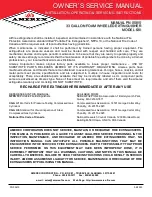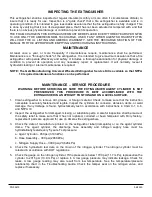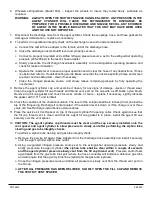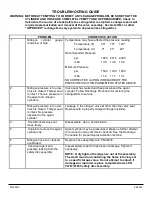
PN 05615
04/2020
INSPECTING THE EXTINGUISHER
This extinguisher shall be inspected at regular intervals (monthly or more often if circumstances dictate) to
insure that it is ready for use. Inspection is a "quick check" that a fire extinguisher is available and is in
operating condition. It is intended to give reasonable assurance that the fire extinguisher is fully charged. This
is done by verifying that it is in its designated place, that it has not been actuated or tampered with, and that
there is no obvious physical damage or condition to prevent its operation.
THE FOAM CHARGE IN THIS EXTINGUISHER MUST BE REPLACED EVERY THREE YEARS PER NFPA
10. USE ONLY THE AMEREX MODEL 534 CHARGE. USE OF ANY OTHER AGENTS OR SUBSTITUTES
WILL VOID THE UL LISTING AND AMEREX WARRANTY. SEE THE RECHARGE SECTION OF THIS
MANUAL FOR THE APPROPRIATE EMPTYING AND RECHARGING INSTRUCTIONS
.
MAINTENANCE
At least once a year, or more frequently if circumstances require, maintenance shall be performed.
Maintenance is a "thorough check" of the extinguisher. It is intended to give maximum assurance that a fire
extinguisher will operate effectively and safely. It includes a thorough examination for physical damage or
condition to prevent its operation and any necessary repair or replacement. It will normally reveal if
hydrostatic testing or internal maintenance is required.
NOTE: The Getz Manufacturing Universal Wheeled Extinguisher Service Kit is available so that NFPA
10 required maintenance functions can be performed.
MAINTENANCE –
SERVICE PROCEDURE
WARNING: BEFORE SERVICING BE SURE THE EXTINGUISHER AGENT CYLINDER IS NOT
PRESSURIZED. THIS PROCEDURE IS BEST ACCOMPLISHED WITH THE
EXTINGUISHER IN AN UPRIGHT POSITION AND ON A LEVEL SURFACE.
1.
Clean extinguisher to remove dirt, grease, or foreign material. Check to make sure that the instruction
nameplate is securely fastened and legible. Inspect the cylinders for corrosion, abrasion, dents, or weld
damage. If any damage is found, hydrostatically test in accordance with instructions in CGA C
-
1, C
-
6,
and NFPA 10.
2.
Inspect the extinguisher for damaged, missing, or substitute parts. A careful inspection shall be made of
the safety relief to make sure that it has not ruptured, corroded or been tampered with. Only factory
-
replacement parts are approved for use on Amerex fire extinguishers.
3.
Check the date of manufacture printed on the extinguisher label (nameplate) or on the agent cylinder
dome. The agent cylinder, the discharge hose assembly and nitrogen supply hose must be
hydrostatically tested every 5 years. Test pressure:
a.
Agent Cylinder –
450
psi (3103 kPa)
b.
Hose Assembly –
300
psi (2068 kPa)
c.
Nitrogen Supply Hose –
3000
psi (20,628 kPa)
4.
Check the hydrostatic test date on the crown of the nitrogen cylinder. The nitrogen cylinder must be
retested in accordance with DOT regulations.
5.
Check the gauge on the nitrogen cylinder. If the pressure is below 1700 psi (11.7 mPa), repressurize the
cylinder to 2015 psi (13.9 mPa) or replace it. A low gauge pressure may indicate leakage. Check for
leaks. A low gauge reading may also result from low temperature. See the temperature/pressure
relationship chart in the Troubleshooting Guide. Check the tamper seal on the nitrogen valve, and
replace if necessary.




























